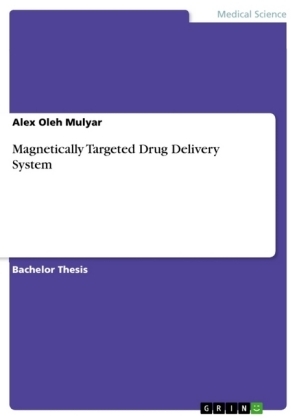
Magnetically Targeted Drug Delivery System
Seiten
2010
|
10004 A. 4. Auflage
GRIN Verlag
978-3-640-78592-6 (ISBN)
GRIN Verlag
978-3-640-78592-6 (ISBN)
- Titel nicht im Sortiment
- Artikel merken
Bachelor Thesis from the year 2010 in the subject Medicine - Pharmacology, grade: 1,0, Harvard University (Division of Continuing Education ), language: English, abstract: Tissue grafts and transplants tend to get rejected by the body, and are also prone to higher rates of infection than other tissues of the human body. Thus, the patient must take immunosuppressant drugs as well as drugs that treat infections, which end up in both the tissues they are targeted for and the rest of the body. These drugs can leave the patient prone to further infection and disease, thus the drugs can end up causing as much harm as the initial infection. Furthermore, cancer and tumor medications have harmful effects on the rest of the body, and even though many of them may have specific affinity for the targeted tissue they end up in nearly the same dosages in the rest of the body since their specified tissue affinities are usually low. The Purpose of this thesis is to discuss alternative ways of delivering medication directly to the targeted tissue or organ and isolate it there. Thus having only minimal-to-none dosage throughout the rest of the body leading to minimal side effects.If a magnetic field can be set up internally by the use of external magnets it may maintain high concentrations of magnetically labeled particles (which will carry medication) within the assigned part of the body at high concentrations while the rest of the body should have zero to very low concentrations. The system to be discussed is based on ferromagnetic particles that absorb medication and are attracted to magnetized coils, which will be inserted in the required area prior to treatment. The inserted coils will be magnetized by the use of externally applied magnetic fields, which will allow for magnetically targeted drug delivery. Thereafter, different types of ferromagnetic nano-particles will be presented and categorized based on their usefulness. The nano-particles usefulness is based on their affinity for drug absorption, toxicity, magnetic capability, and ease with which they can be removed from the body once treatment is complete. Secondly, the types of magnetic coils will be discussed; how the coils can be inserted, how they work, their toxicity, and removal mechanisms will be reviewed. Lastly, the factors of the magnetic field required to make this delivery mechanism work will be examined; factors such as strength required to keep the particles in the specified tissue, side effects the field may cause, and whether these magnets can be made portable to be used by a patient outside the hospital.
| Sprache | englisch |
|---|---|
| Maße | 148 x 210 mm |
| Gewicht | 83 g |
| Themenwelt | Sachbuch/Ratgeber ► Beruf / Finanzen / Recht / Wirtschaft ► Erben / Vererben |
| Sachbuch/Ratgeber ► Beruf / Finanzen / Recht / Wirtschaft ► Recht / Sonstiges | |
| Medizin / Pharmazie ► Pharmazie | |
| Schlagworte | Delivery • Drug • Magnetically • System • targeted |
| ISBN-10 | 3-640-78592-4 / 3640785924 |
| ISBN-13 | 978-3-640-78592-6 / 9783640785926 |
| Zustand | Neuware |
| Haben Sie eine Frage zum Produkt? |
Mehr entdecken
aus dem Bereich
aus dem Bereich
Elternhaus auflösen – sortieren, wertschätzen, loslassen
Buch | Softcover (2023)
Rowohlt Taschenbuch (Verlag)
CHF 25,90
Textbausteine, Mustertestamente, Checklisten
Buch | Softcover (2023)
Verbraucher-Zentrale NRW (Verlag)
CHF 25,20
Handbuch für den Trauerfall
Buch | Softcover (2024)
Verbraucher-Zentrale NRW (Verlag)
CHF 25,20


